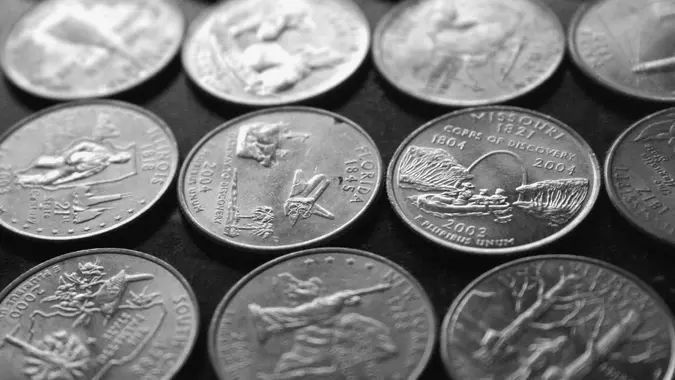5 Key Reasons You Shouldn’t Pay With a Personal Check

Commitment to Our Readers
GOBankingRates' editorial team is committed to bringing you unbiased reviews and information. We use data-driven methodologies to evaluate financial products and services - our reviews and ratings are not influenced by advertisers. You can read more about our editorial guidelines and our products and services review methodology.

20 Years
Helping You Live Richer

Reviewed
by Experts

Trusted by
Millions of Readers
Many Americans most likely can’t recall the last time they wrote out a check. Nearly 46% of Americans didn’t write out a personal check in 2023, and with many major retailers no longer accepting check payments, there’s no doubt that the personal check is slowly fading away.
Checks are steadily declining in popularity as quicker payment options have become the norm, yet some Americans still write out checks for certain situations like paying bills or large transactions. However, there are several reasons paying with a check is not recommended and other payment methods should be used instead.
Here are several reasons you should avoid paying with a personal check.
Check Fraud
One of the biggest reasons that experts advise consumers to avoid checks is the fraud risk that comes with them. If you do pay with a check, it’s important to maintain a constant watch on your bank account and directly hand in your check to avoid mail theft — one of the leading causes of check fraud.
“Today, the shift towards digital payments, like Zelle and Venmo, is not just a trend, it’s a necessity for your financial security,” said Craig Costigan, CEO of NICE Actimize, a financial fraud solutions company. “These methods are more secure than checks and get your payment to your friend or family member faster. If you must use a check, the best thing to do is to limit the use of checks to individuals you know and trust and hand the check directly to the recipient.”
As recent studies show that financial fraud is on the rise and people are finding new ways to steal your personal information, it’s essential to be protective of your bank account and personal information.
“If you can, try to minimize your use of paper checks when possible,” said Yinglian Xie, CEO and co-founder of Data Visor, a fraud management company. “Digital payments are more secure and efficient, making them a better option in a lot of instances. But when you do need to use a check, make sure you’re banking with a reliable institution that has strong fraud protection.”
A Long Time To Process
Unlike digital payments, checks do not process instantly. Therefore, paying with a check could mess with your bank account balance if you’re not careful.
“In today’s world, waiting days or weeks for a payment to clear is unacceptable,” said Seton Marshall, CFO at Dash Solutions, a financial services company that offers digital payment solutions for businesses. “The truth is that checks are simply outdated. We have secure, instant digital payment options available. Writing a check is like using a rotary phone in the age of smartphones.”
Bounced Checks
Additionally, unlike digital payments, paying with a check comes with the risk of bounced checks.
“Unlike digital payments that can verify funds instantly, checks can bounce, leading to fees, damaged credit and strained relationships with various service providers,” Marshall said.
Many Retailers Don’t Accept Checks
Another main reason to avoid paying with checks is that many large retailers no longer accept check payments. The amount of stores that no longer accept checks is growing, with the most recent chain to join being Target — the largest retailer to no longer accept check payments. Other stores include Whole Foods, Aldi and Old Navy.
According to AARP, stores are no longer accepting checks for several reasons. The longer processing fees and fraud risk are the primary reasons, but as we live in a day and age where shoppers want a quicker checkout experience, retailers don’t want customers to deal with the tediousness of writing out a check when making a purchase.
Easy To Lose
Unlike digital payments, where everything can be monitored online or through your phone, paper checks are easy to lose or misplace. Alternatively, digital transactions are logged automatically and easily accessible.
“This makes it significantly easier for consumers and businesses to manage their finances, track expenses and prepare for tax season,” Marshall said. “Both businesses and consumers are realizing the benefits of digital payments — better security, faster processing, improved record-keeping and easier financial management overall.”
What To Use Instead of a Check
Ultimately, in a technologically advanced and fast-paced world, the concept of writing out a paper check has become outdated and inefficient compared to alternative forms of payment. If you want to pay somebody back or gift money, money transfer apps such as PayPal and Venmo are easy platforms to use to pull money directly from your checking account.
Furthermore, if you have typically relied on personal checks, similar options are available. Wire transfers, money orders and cashier’s checks are similar to personal checks, except they are safer and come with less fraud risk.
When To Pay With a Personal Check
While the majority of businesses and consumers have opted out of check payments entirely, there are some instances where paying with a check is still appropriate.
“Checks can still make sense in certain situations — like when you need to pay a contractor or someone who doesn’t accept digital payments, especially if you want a paper trail for a large payment,” said Andrew Latham, content director at Super Money. “They’re also handy with businesses that charge a credit card surcharge.”
 Written by
Written by 

























